Business Law and Ethics: Tort of Negligence Case Study Report
VerifiedAdded on 2023/01/11
|7
|1612
|86
Report
AI Summary
This report presents a case study in Business Law and Ethics, focusing on the tort of negligence. The scenario involves a customer, Samantha, who is injured at a bank due to a misplaced carpet. The report explores the legal principles of negligence, including duty of care, breach of duty, causation, and harm. It analyzes the case, considering the bank's responsibility, the clause limiting liability, and prior incidents. Applying the principles of tort law, the report concludes that the bank is liable for Samantha's injuries. The analysis highlights the four elements of negligence – duty, breach, causation, and harm – and discusses compensation policies. The report emphasizes the importance of businesses adhering to laws and regulations to avoid legal repercussions, and the report uses the case to demonstrate the practical application of the tort of negligence.
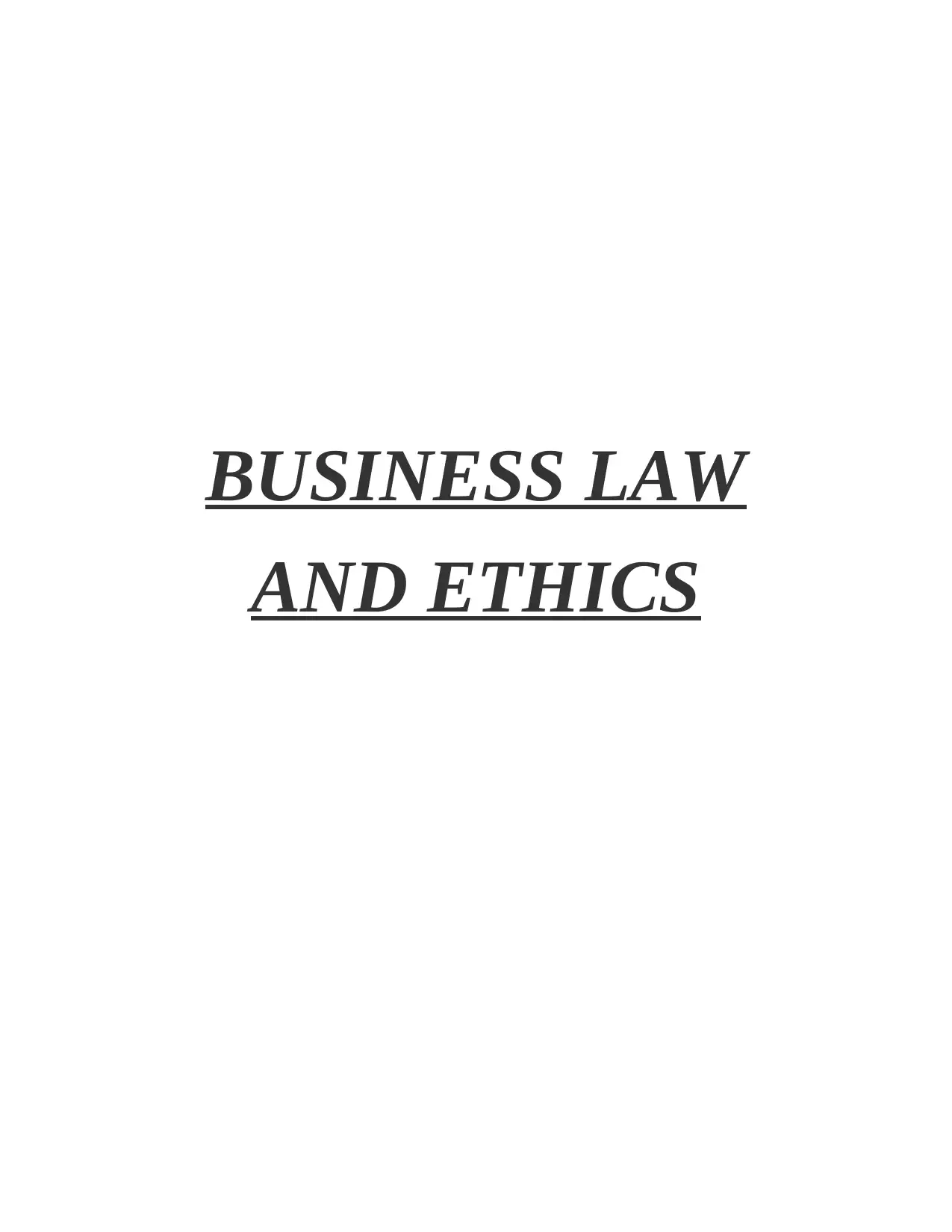
BUSINESS LAW
AND ETHICS
AND ETHICS
Secure Best Marks with AI Grader
Need help grading? Try our AI Grader for instant feedback on your assignments.
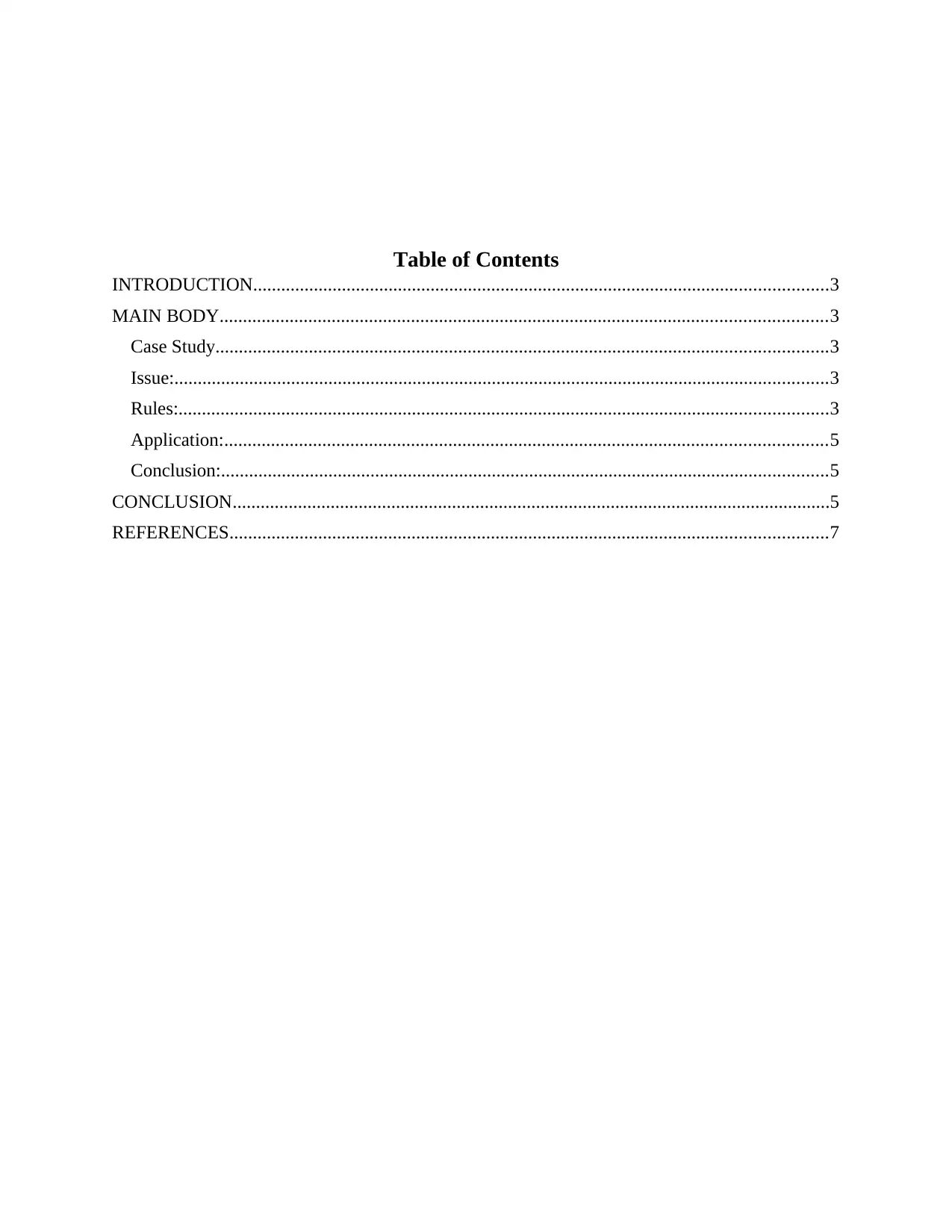
Table of Contents
INTRODUCTION...........................................................................................................................3
MAIN BODY..................................................................................................................................3
Case Study...................................................................................................................................3
Issue:............................................................................................................................................3
Rules:...........................................................................................................................................3
Application:.................................................................................................................................5
Conclusion:..................................................................................................................................5
CONCLUSION................................................................................................................................5
REFERENCES................................................................................................................................7
INTRODUCTION...........................................................................................................................3
MAIN BODY..................................................................................................................................3
Case Study...................................................................................................................................3
Issue:............................................................................................................................................3
Rules:...........................................................................................................................................3
Application:.................................................................................................................................5
Conclusion:..................................................................................................................................5
CONCLUSION................................................................................................................................5
REFERENCES................................................................................................................................7
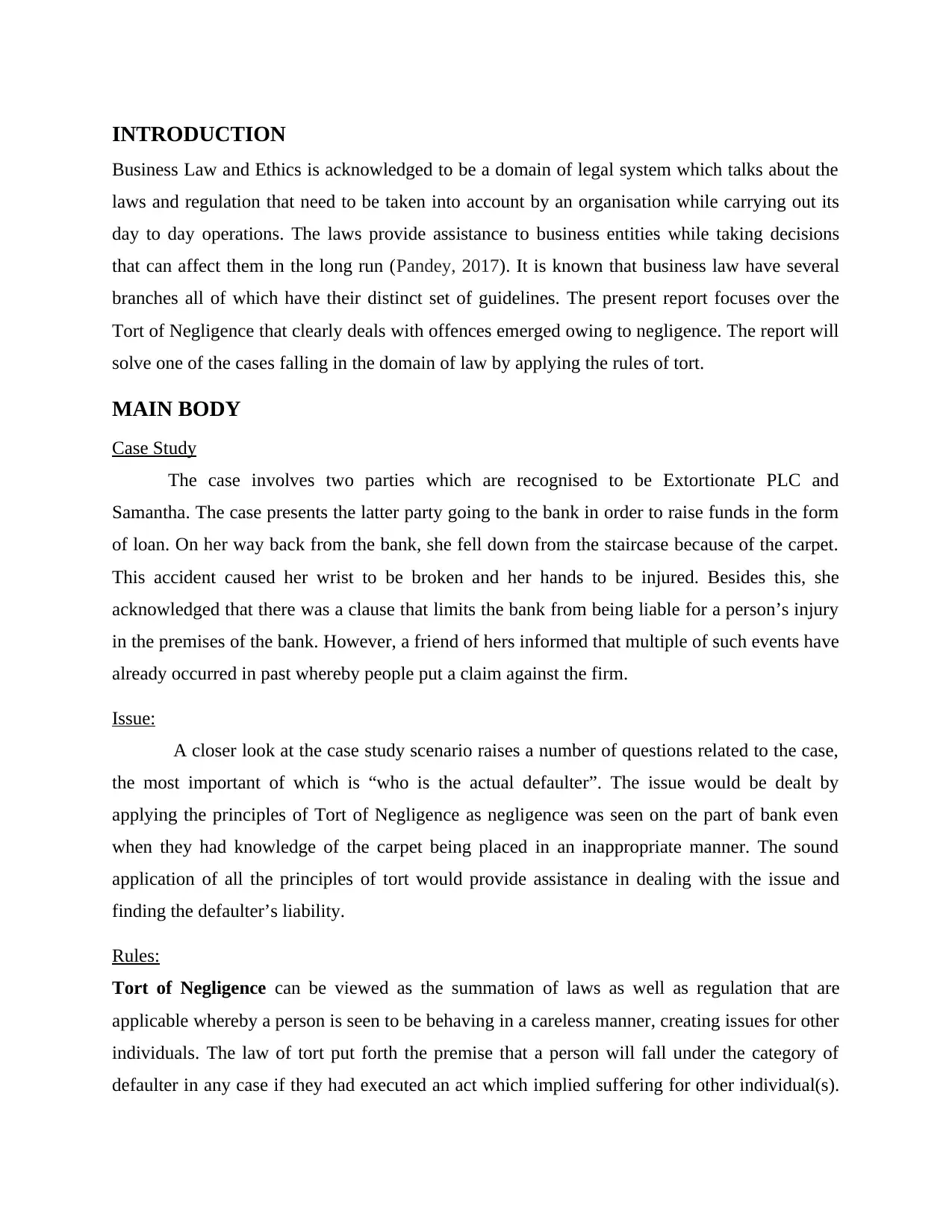
INTRODUCTION
Business Law and Ethics is acknowledged to be a domain of legal system which talks about the
laws and regulation that need to be taken into account by an organisation while carrying out its
day to day operations. The laws provide assistance to business entities while taking decisions
that can affect them in the long run (Pandey, 2017). It is known that business law have several
branches all of which have their distinct set of guidelines. The present report focuses over the
Tort of Negligence that clearly deals with offences emerged owing to negligence. The report will
solve one of the cases falling in the domain of law by applying the rules of tort.
MAIN BODY
Case Study
The case involves two parties which are recognised to be Extortionate PLC and
Samantha. The case presents the latter party going to the bank in order to raise funds in the form
of loan. On her way back from the bank, she fell down from the staircase because of the carpet.
This accident caused her wrist to be broken and her hands to be injured. Besides this, she
acknowledged that there was a clause that limits the bank from being liable for a person’s injury
in the premises of the bank. However, a friend of hers informed that multiple of such events have
already occurred in past whereby people put a claim against the firm.
Issue:
A closer look at the case study scenario raises a number of questions related to the case,
the most important of which is “who is the actual defaulter”. The issue would be dealt by
applying the principles of Tort of Negligence as negligence was seen on the part of bank even
when they had knowledge of the carpet being placed in an inappropriate manner. The sound
application of all the principles of tort would provide assistance in dealing with the issue and
finding the defaulter’s liability.
Rules:
Tort of Negligence can be viewed as the summation of laws as well as regulation that are
applicable whereby a person is seen to be behaving in a careless manner, creating issues for other
individuals. The law of tort put forth the premise that a person will fall under the category of
defaulter in any case if they had executed an act which implied suffering for other individual(s).
Business Law and Ethics is acknowledged to be a domain of legal system which talks about the
laws and regulation that need to be taken into account by an organisation while carrying out its
day to day operations. The laws provide assistance to business entities while taking decisions
that can affect them in the long run (Pandey, 2017). It is known that business law have several
branches all of which have their distinct set of guidelines. The present report focuses over the
Tort of Negligence that clearly deals with offences emerged owing to negligence. The report will
solve one of the cases falling in the domain of law by applying the rules of tort.
MAIN BODY
Case Study
The case involves two parties which are recognised to be Extortionate PLC and
Samantha. The case presents the latter party going to the bank in order to raise funds in the form
of loan. On her way back from the bank, she fell down from the staircase because of the carpet.
This accident caused her wrist to be broken and her hands to be injured. Besides this, she
acknowledged that there was a clause that limits the bank from being liable for a person’s injury
in the premises of the bank. However, a friend of hers informed that multiple of such events have
already occurred in past whereby people put a claim against the firm.
Issue:
A closer look at the case study scenario raises a number of questions related to the case,
the most important of which is “who is the actual defaulter”. The issue would be dealt by
applying the principles of Tort of Negligence as negligence was seen on the part of bank even
when they had knowledge of the carpet being placed in an inappropriate manner. The sound
application of all the principles of tort would provide assistance in dealing with the issue and
finding the defaulter’s liability.
Rules:
Tort of Negligence can be viewed as the summation of laws as well as regulation that are
applicable whereby a person is seen to be behaving in a careless manner, creating issues for other
individuals. The law of tort put forth the premise that a person will fall under the category of
defaulter in any case if they had executed an act which implied suffering for other individual(s).
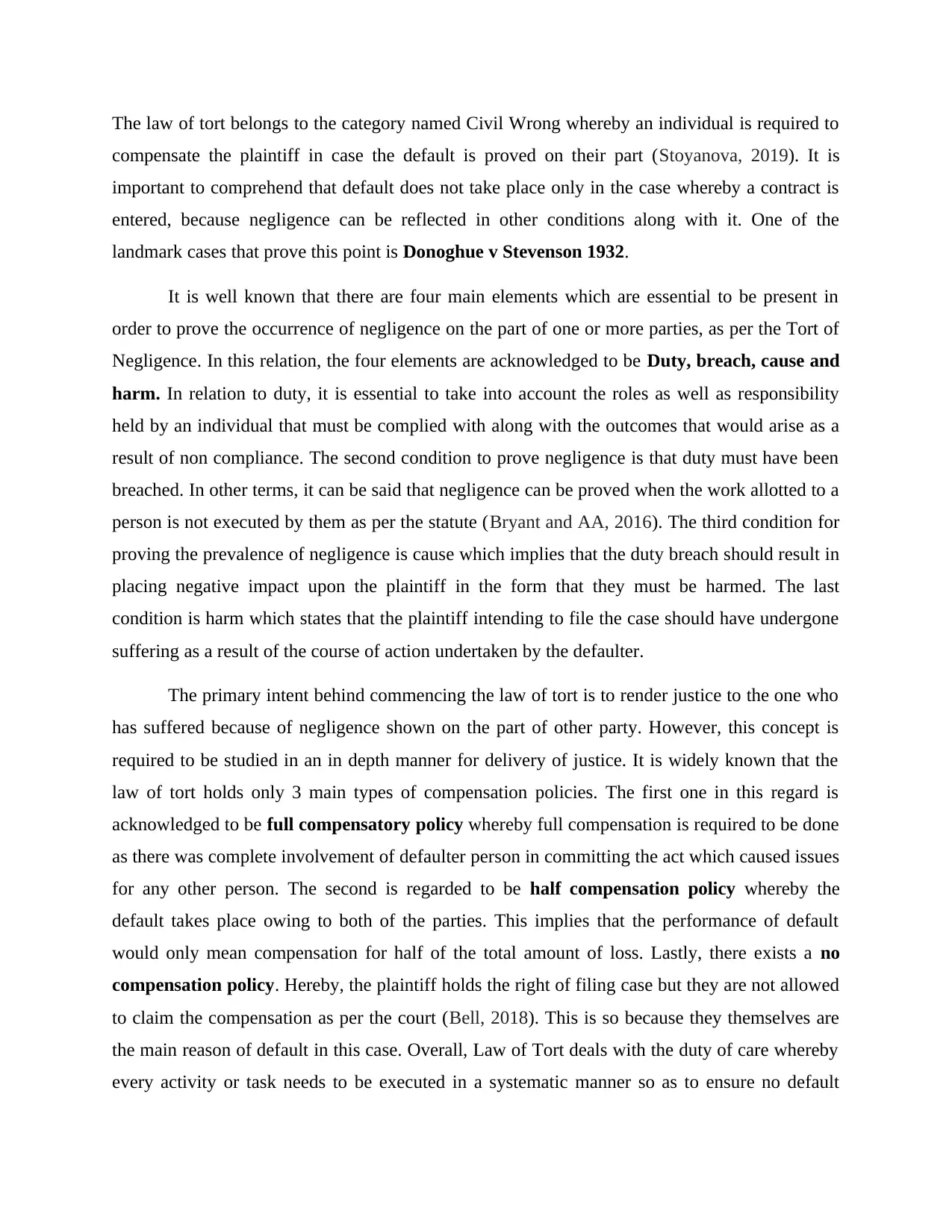
The law of tort belongs to the category named Civil Wrong whereby an individual is required to
compensate the plaintiff in case the default is proved on their part (Stoyanova, 2019). It is
important to comprehend that default does not take place only in the case whereby a contract is
entered, because negligence can be reflected in other conditions along with it. One of the
landmark cases that prove this point is Donoghue v Stevenson 1932.
It is well known that there are four main elements which are essential to be present in
order to prove the occurrence of negligence on the part of one or more parties, as per the Tort of
Negligence. In this relation, the four elements are acknowledged to be Duty, breach, cause and
harm. In relation to duty, it is essential to take into account the roles as well as responsibility
held by an individual that must be complied with along with the outcomes that would arise as a
result of non compliance. The second condition to prove negligence is that duty must have been
breached. In other terms, it can be said that negligence can be proved when the work allotted to a
person is not executed by them as per the statute (Bryant and AA, 2016). The third condition for
proving the prevalence of negligence is cause which implies that the duty breach should result in
placing negative impact upon the plaintiff in the form that they must be harmed. The last
condition is harm which states that the plaintiff intending to file the case should have undergone
suffering as a result of the course of action undertaken by the defaulter.
The primary intent behind commencing the law of tort is to render justice to the one who
has suffered because of negligence shown on the part of other party. However, this concept is
required to be studied in an in depth manner for delivery of justice. It is widely known that the
law of tort holds only 3 main types of compensation policies. The first one in this regard is
acknowledged to be full compensatory policy whereby full compensation is required to be done
as there was complete involvement of defaulter person in committing the act which caused issues
for any other person. The second is regarded to be half compensation policy whereby the
default takes place owing to both of the parties. This implies that the performance of default
would only mean compensation for half of the total amount of loss. Lastly, there exists a no
compensation policy. Hereby, the plaintiff holds the right of filing case but they are not allowed
to claim the compensation as per the court (Bell, 2018). This is so because they themselves are
the main reason of default in this case. Overall, Law of Tort deals with the duty of care whereby
every activity or task needs to be executed in a systematic manner so as to ensure no default
compensate the plaintiff in case the default is proved on their part (Stoyanova, 2019). It is
important to comprehend that default does not take place only in the case whereby a contract is
entered, because negligence can be reflected in other conditions along with it. One of the
landmark cases that prove this point is Donoghue v Stevenson 1932.
It is well known that there are four main elements which are essential to be present in
order to prove the occurrence of negligence on the part of one or more parties, as per the Tort of
Negligence. In this relation, the four elements are acknowledged to be Duty, breach, cause and
harm. In relation to duty, it is essential to take into account the roles as well as responsibility
held by an individual that must be complied with along with the outcomes that would arise as a
result of non compliance. The second condition to prove negligence is that duty must have been
breached. In other terms, it can be said that negligence can be proved when the work allotted to a
person is not executed by them as per the statute (Bryant and AA, 2016). The third condition for
proving the prevalence of negligence is cause which implies that the duty breach should result in
placing negative impact upon the plaintiff in the form that they must be harmed. The last
condition is harm which states that the plaintiff intending to file the case should have undergone
suffering as a result of the course of action undertaken by the defaulter.
The primary intent behind commencing the law of tort is to render justice to the one who
has suffered because of negligence shown on the part of other party. However, this concept is
required to be studied in an in depth manner for delivery of justice. It is widely known that the
law of tort holds only 3 main types of compensation policies. The first one in this regard is
acknowledged to be full compensatory policy whereby full compensation is required to be done
as there was complete involvement of defaulter person in committing the act which caused issues
for any other person. The second is regarded to be half compensation policy whereby the
default takes place owing to both of the parties. This implies that the performance of default
would only mean compensation for half of the total amount of loss. Lastly, there exists a no
compensation policy. Hereby, the plaintiff holds the right of filing case but they are not allowed
to claim the compensation as per the court (Bell, 2018). This is so because they themselves are
the main reason of default in this case. Overall, Law of Tort deals with the duty of care whereby
every activity or task needs to be executed in a systematic manner so as to ensure no default
Secure Best Marks with AI Grader
Need help grading? Try our AI Grader for instant feedback on your assignments.
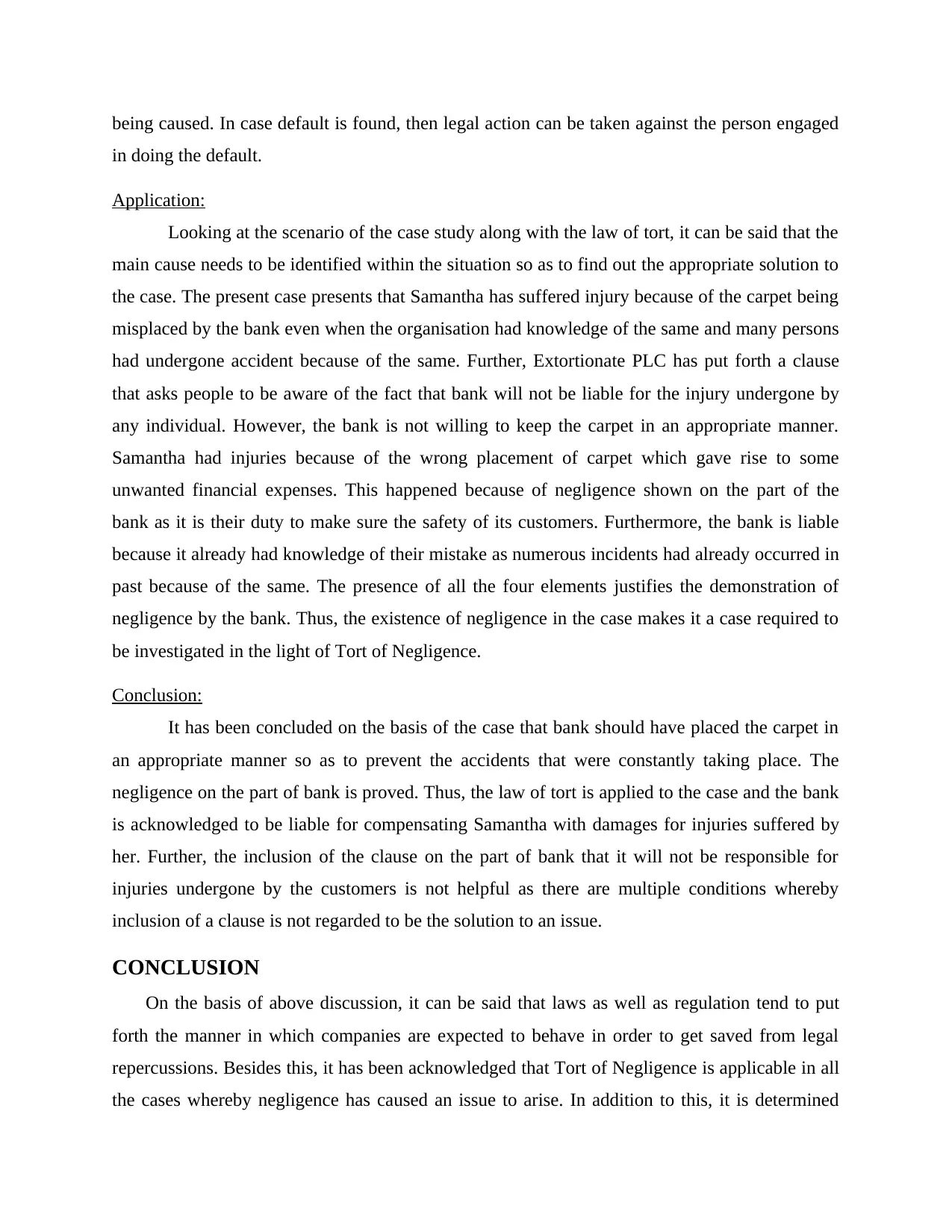
being caused. In case default is found, then legal action can be taken against the person engaged
in doing the default.
Application:
Looking at the scenario of the case study along with the law of tort, it can be said that the
main cause needs to be identified within the situation so as to find out the appropriate solution to
the case. The present case presents that Samantha has suffered injury because of the carpet being
misplaced by the bank even when the organisation had knowledge of the same and many persons
had undergone accident because of the same. Further, Extortionate PLC has put forth a clause
that asks people to be aware of the fact that bank will not be liable for the injury undergone by
any individual. However, the bank is not willing to keep the carpet in an appropriate manner.
Samantha had injuries because of the wrong placement of carpet which gave rise to some
unwanted financial expenses. This happened because of negligence shown on the part of the
bank as it is their duty to make sure the safety of its customers. Furthermore, the bank is liable
because it already had knowledge of their mistake as numerous incidents had already occurred in
past because of the same. The presence of all the four elements justifies the demonstration of
negligence by the bank. Thus, the existence of negligence in the case makes it a case required to
be investigated in the light of Tort of Negligence.
Conclusion:
It has been concluded on the basis of the case that bank should have placed the carpet in
an appropriate manner so as to prevent the accidents that were constantly taking place. The
negligence on the part of bank is proved. Thus, the law of tort is applied to the case and the bank
is acknowledged to be liable for compensating Samantha with damages for injuries suffered by
her. Further, the inclusion of the clause on the part of bank that it will not be responsible for
injuries undergone by the customers is not helpful as there are multiple conditions whereby
inclusion of a clause is not regarded to be the solution to an issue.
CONCLUSION
On the basis of above discussion, it can be said that laws as well as regulation tend to put
forth the manner in which companies are expected to behave in order to get saved from legal
repercussions. Besides this, it has been acknowledged that Tort of Negligence is applicable in all
the cases whereby negligence has caused an issue to arise. In addition to this, it is determined
in doing the default.
Application:
Looking at the scenario of the case study along with the law of tort, it can be said that the
main cause needs to be identified within the situation so as to find out the appropriate solution to
the case. The present case presents that Samantha has suffered injury because of the carpet being
misplaced by the bank even when the organisation had knowledge of the same and many persons
had undergone accident because of the same. Further, Extortionate PLC has put forth a clause
that asks people to be aware of the fact that bank will not be liable for the injury undergone by
any individual. However, the bank is not willing to keep the carpet in an appropriate manner.
Samantha had injuries because of the wrong placement of carpet which gave rise to some
unwanted financial expenses. This happened because of negligence shown on the part of the
bank as it is their duty to make sure the safety of its customers. Furthermore, the bank is liable
because it already had knowledge of their mistake as numerous incidents had already occurred in
past because of the same. The presence of all the four elements justifies the demonstration of
negligence by the bank. Thus, the existence of negligence in the case makes it a case required to
be investigated in the light of Tort of Negligence.
Conclusion:
It has been concluded on the basis of the case that bank should have placed the carpet in
an appropriate manner so as to prevent the accidents that were constantly taking place. The
negligence on the part of bank is proved. Thus, the law of tort is applied to the case and the bank
is acknowledged to be liable for compensating Samantha with damages for injuries suffered by
her. Further, the inclusion of the clause on the part of bank that it will not be responsible for
injuries undergone by the customers is not helpful as there are multiple conditions whereby
inclusion of a clause is not regarded to be the solution to an issue.
CONCLUSION
On the basis of above discussion, it can be said that laws as well as regulation tend to put
forth the manner in which companies are expected to behave in order to get saved from legal
repercussions. Besides this, it has been acknowledged that Tort of Negligence is applicable in all
the cases whereby negligence has caused an issue to arise. In addition to this, it is determined

that Duty, breach, cause and harm are the most elements that must be present in order to prove
the prevalence of negligence in the case on the part of one or more parties.
the prevalence of negligence in the case on the part of one or more parties.
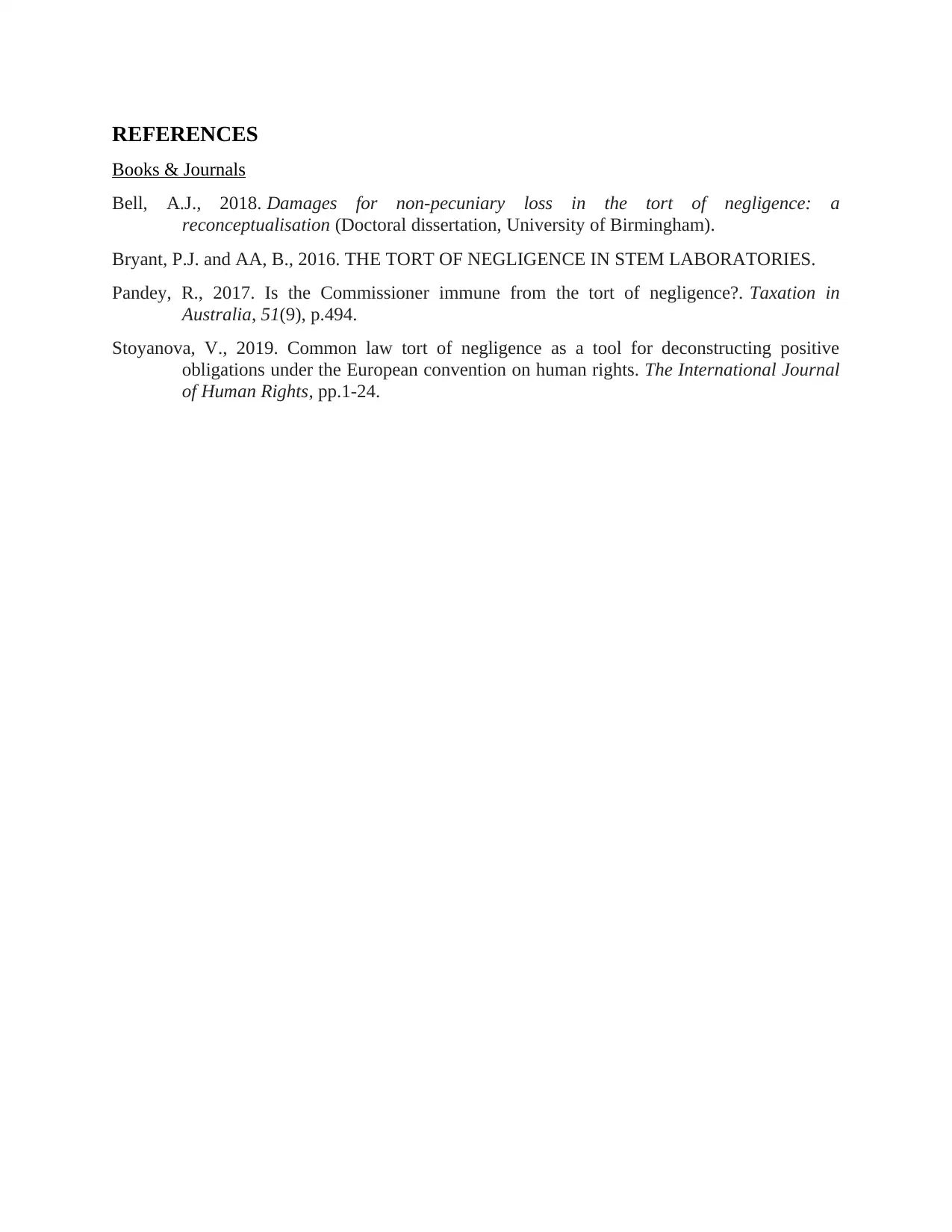
REFERENCES
Books & Journals
Bell, A.J., 2018. Damages for non-pecuniary loss in the tort of negligence: a
reconceptualisation (Doctoral dissertation, University of Birmingham).
Bryant, P.J. and AA, B., 2016. THE TORT OF NEGLIGENCE IN STEM LABORATORIES.
Pandey, R., 2017. Is the Commissioner immune from the tort of negligence?. Taxation in
Australia, 51(9), p.494.
Stoyanova, V., 2019. Common law tort of negligence as a tool for deconstructing positive
obligations under the European convention on human rights. The International Journal
of Human Rights, pp.1-24.
Books & Journals
Bell, A.J., 2018. Damages for non-pecuniary loss in the tort of negligence: a
reconceptualisation (Doctoral dissertation, University of Birmingham).
Bryant, P.J. and AA, B., 2016. THE TORT OF NEGLIGENCE IN STEM LABORATORIES.
Pandey, R., 2017. Is the Commissioner immune from the tort of negligence?. Taxation in
Australia, 51(9), p.494.
Stoyanova, V., 2019. Common law tort of negligence as a tool for deconstructing positive
obligations under the European convention on human rights. The International Journal
of Human Rights, pp.1-24.
1 out of 7
Related Documents
Your All-in-One AI-Powered Toolkit for Academic Success.
+13062052269
info@desklib.com
Available 24*7 on WhatsApp / Email
![[object Object]](/_next/static/media/star-bottom.7253800d.svg)
Unlock your academic potential
© 2024 | Zucol Services PVT LTD | All rights reserved.





